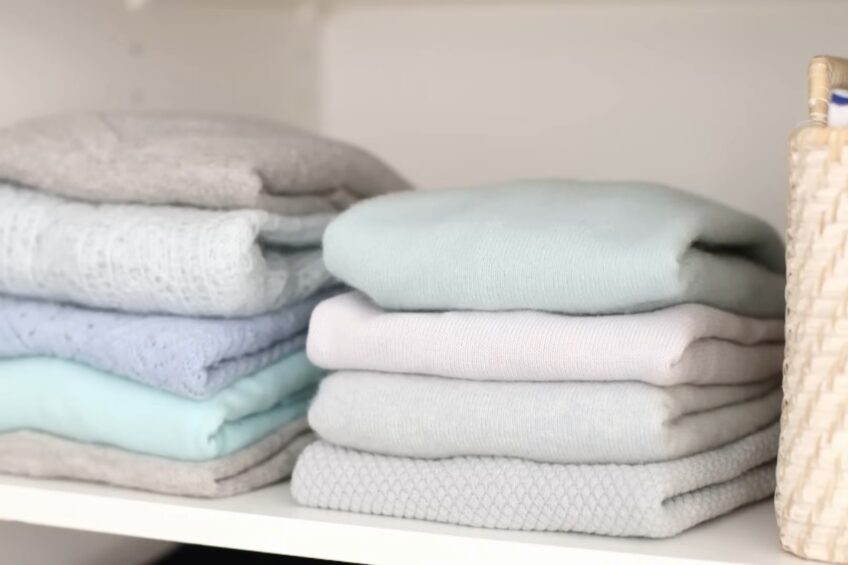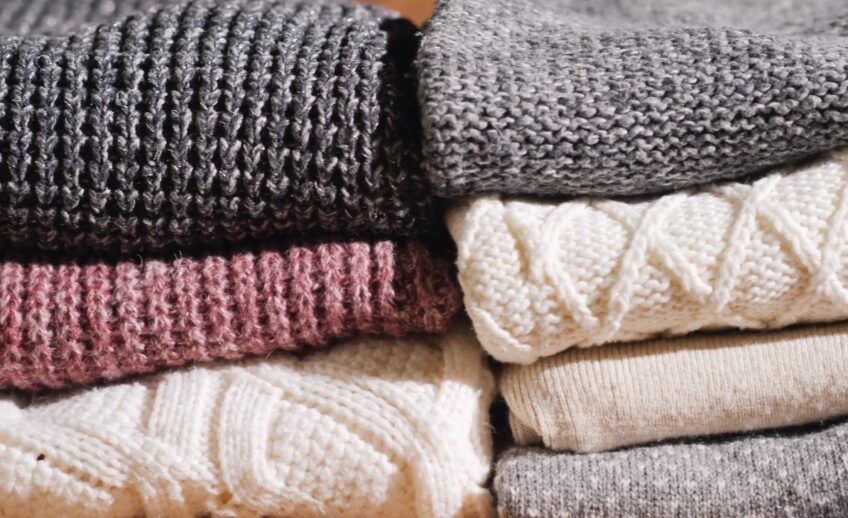Sweaters, with their cozy textures and varied designs, are one of the most favorite pieces for many people, especially for the upcoming fall season. However, their unique fabrics and structures can make storage a challenge.
Also, now is the right time to take out your sweaters from the last season, and clean them. While you’re at it, if you have wicker baskets that need a refresh, learn how to clean them properly.
On the other hand, folding them in the right way will help you keep them in a better condition. These are the best ways to store your sweaters.
1. Fold, Don’t Hang

Hanging sweaters, especially those made of delicate or heavy materials, can lead to unwanted stretching. Over time, this can permanently damage the sweater’s structure, making it less flattering when worn.
To fold it correctly, lay it flat on a clean surface. Smooth out any wrinkles, fold the sleeves inward, and then fold it in half from bottom to top.
This method not only ensures that the clothes retains its original shape but also minimizes the risk of creases. Regularly folding and refolding can also help redistribute the natural fibers, ensuring even wear over time.
2. Use Drawer Dividers

Drawer dividers are more than just organizational tools. They help maximize space, allowing you to categorize different pieces by material, style, or color. This systematic approach ensures that you can quickly locate your desired sweater, but also to secure a good condition for a longer time.
Moreover, the protective barriers will prevent sweaters from rubbing against each other. This separation is crucial for delicate fabrics that are prone to snags or pilling. Over time, this can help maintain the texture and appearance, ensuring it looks new for longer.
3. Store in Clear Plastic Bins

Clear plastic bins offer a dual advantage. Firstly, they allow you to quickly identify the contents, reducing the need to sift through multiple sweaters. This not only saves time but also reduces the potential for damage.
Furthermore, plastic bins provide a protective shield against common storage threats like dust, moisture, and pests. By sealing your sweaters in these containers, you’re ensuring they remain uncontaminated and fresh, ready for the next wear.
4. Use Acid-Free Tissue Paper
Some sweaters, particularly those with rich dyes, can bleed or transfer colors onto other fabrics. Acid-free tissue paper acts as a barrier, preventing this transfer and ensuring each one retains its features.
Beyond color protection, tissue paper provides a gentle cushioning for your sweaters. This buffer helps maintain the sweater’s form, especially during extended storage periods, and reduces the risk of creases or folds setting into the fabric.
5. Vacuum Seal for Long-Term Storage

Vacuum sealing is an innovative way to store sweaters, especially if space is at a premium. By extracting the air, the storage volume reduces dramatically, allowing for efficient use of space.
These bags offer a near-perfect barrier against external elements. Whether it’s moisture, pests, or dust, these sealed bags ensure that your sweaters remain untouched and in pristine condition, even if stored for extended periods.
6. Cedar Blocks or Lavender Sachets
Moths can wreak havoc on sweaters. Cedar blocks and lavender sachets are natural deterrents, repelling these pests and ensuring your sweaters remain hole-free. These natural solutions are preferable to chemical mothballs, which can impart a strong odor to fabrics.
Beyond their protective qualities, cedar and lavender impart a pleasant, refreshing scent to your storage area and the sweaters themselves. This gentle aroma can make wearing the sweater a more pleasant experience, especially after prolonged storage.
7. Rotate

By systematically rotating your sweaters, you ensure each piece gets an equal amount of wear. This practice prevents certain sweaters from bearing the brunt of regular use, ensuring a more uniform aging process for your collection.
Regular rotation also means that each piece gets periodic rests, reducing continuous strain on any single piece. This can extend the overall lifespan of your sweaters, ensuring they remain in wearable condition for longer.
8. Avoid Overpacking
Cramming sweaters into a confined space can lead to compression, which in turn can cause wrinkles and distort the sweater’s shape. By ensuring there’s ample space in your storage solution, you allow each one to maintain its form.
A less congested storage space also facilitates easier access. This means less rummaging, reducing the risk of unintentional snags or damage when retrieving or storing.
9. Store in a Cool, Dry Place
A damp environment is a breeding ground for mold and mildew. These fungi can not only produce a foul odor but also damage the fabric of your sweaters. By ensuring your storage space is cool and dry, you’re taking a proactive step against these threats.
Direct sunlight can be detrimental to the colors of your sweaters. Over time, UV rays can cause fading or discoloration. By storing your sweaters away from direct sunlight, you help maintain their vibrant colors and overall appearance.
Material Can Make a Difference

There is a wide range of materials to choose from. However, not all of them will provide the same resistance, appearance, and other features. Also, some of them are easier to maintain and keep in your wardrobe for a longer time.
Just as it’s crucial to address cooking oil stains promptly to maintain the quality of your clothes, the material of your sweater plays a significant role in its longevity.
Wool
This is a classic and enduring choice, which is providing great resistance to wear and tear. Its natural properties make it both warm and resilient, capable of withstanding years of use without losing its shape or succumbing to pilling.
Cashmere
Cashmere is another natural fiber that stands out for its luxurious feel and surprising resilience. Despite its delicate appearance, high-quality cashmere sweaters can endure daily wear and still look impeccable for years. Proper care and maintenance are essential, but the investment is well worth it.
Synthetic Blends
Materials like polyester or nylon introduce a new dimension of durability to sweaters. These materials are known for their resistance to stretching, fading, and wrinkling. When combined with natural fibers, they create sweaters that maintain their shape and appearance even after extensive use.
FAQs
Can I store my sweaters in a basement or garage?
It’s not ideal to store sweaters in damp environments like basements or garages, as moisture can promote mold and mildew growth, leading to foul odors and fabric damage. It’s best to store sweaters in a cool, dry place.
Are there any specific care tips for cashmere to ensure they last longer?
Cashmere sweaters are delicate but can last for years with proper care. Avoid hanging them, fold them neatly, and use acid-free tissue paper to protect them from color transfer. It’s also essential to follow the manufacturer’s care instructions.
What’s the best way to store sweaters made from synthetic blends to maintain their appearance?
These models made from synthetic blends, like polyester or nylon, are naturally durable. To maintain their appearance, simply follow the general storage guidelines mentioned in the article, such as folding instead of hanging and using proper storage containers.
The Bottom Line
As you can see, there are different ways to keep your clothes in the best condition for a longer time. However, you will have to pay attention to different factors like the material, types of wardrobes, humidity, and more. Also, ensuring your sweaters are stored correctly is crucial for their longevity, it’s equally important to maintain the brightness of your linens; learn some effective methods to rejuvenate your sweaters, towels, and other clothes. These are the best ways to store your sweaters.

